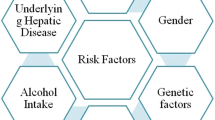Abstract
Hepatocellular carcinoma (HCC) is one of the most common malignant tumors. HCC occurs mainly in patients with chronic liver disease such as in hepatitis B and C infection. These high-risk patients are closely followed up, and increasing numbers of small equivocal lesions are detected by imaging diagnosis. They are now widely recognized as a precursor or early stage of HCC and are classified as dysplastic nodules or early HCC. It is considered that early HCC is a key step in the process of HCC development and progression. However, the molecular mechanisms of early hepatocarcinogenesis are far from clear. Specific mutations of classical oncogenes or tumor suppressor genes have not been identified in early HCC so far. Recent progress in comprehensive analysis of gene expression is shedding some light on this issue. It has been reported that HSP70, CAP2, glypican 3, and glutamine synthetase could serve as molecular markers for early HCC. Further analysis is expected to evaluate their usefulness in routine pathological diagnosis including biopsy diagnosis and also as serum markers for early detection of HCC.
Similar content being viewed by others
References
Arakawa M, Kage M, Sugihara S, Nakashima T, Suenaga M, Okuda K. Emergence of malignant lesions within an adenomatous hyperplastic nodule in a cirrhotic liver. Observations in five cases. Gastroenterology 1986;91:198–208.
Tsuda H, Hirohashi S, Shimamoto Y, Terada M, Hasegawa H. Clonal origin of atypical adenomatous hyperplasia of the liver and clonal identity with hepatocellular carcinoma. Gastroenterology 1988;95:1664–1666.
Takayama T, Makuuchi M, Hirohashi S, Sakaomoto M, Okazaki N, Takayasu K, et al. Malignant transformation of adenomatous hyperplasia to hepatocellular carcinoma. Lancet 1990;336:1150–1153.
Sakamoto M, Hirohashi S, Shimamoto Y. Early stages of multi-step hepatocarcinogenesis: adenomatous hyperplasia and early hepatocellular carcinoma. Hum Pathol 1991;22:172–178.
Hirohashi S, Ishak KG, Kojiro M, Puig PL, Wanless IR, Fischer HP, et al. Hepatocellular carcinoma. In: Hamilton SR, Aaltonen LA, editors. Pathology and genetics of tumors of the digestive system. Lyon: IARC Press; 2000. p. 159–172.
Kojiro M. Pathology of hepatocellular carcinoma. Oxford: Blackwell; 2006.
Matsui O, Kadoya M, Kameyama T, Yoshikawa J, Takashima T, Nakanuma Y, Unoura M, et al. Benign and malignant nodules in cirrhotic livers: distinction based on blood supply. Radiology 1991;178:493–497.
Kudo M. Morphological diagnosis of hepatocellular carcinoma: special emphasis on intranodular hemodynamic imaging. Hepatogastroenterology 1998;45:1226–1231.
Takayama T, Makuuchi M, Hirohashi S, Sakamoto M, Yamamoto J, Shimada K, et al. Early hepatocellular carcinoma as an entity with a high rate of surgical cure. Hepatology 1998;28:1241–1246.
Sakamoto M, Hirohashi S. Natural history and prognosis of adenomatous hyperplasia and early hepatocellular carcinoma: multiinstitutional analysis of 53 nodules followed up for more than 6 months and 141 patients with single early hepatocellular carcinoma treated by surgical resection or percutaneous ethanol injection. Jpn J Clin Oncol 1998;28:604–608.
Chuma M, Sakamoto M, Yamazaki K, Ohta T, Ohki M, Asaka M, Hirohashi S. Expression profiling in multistage hepatocarcinogenesis: identification of HSP70 as a molecular marker of early hepatocellular carcinoma. Hepatology 2003;37:198–207.
Shibata R, Mori T, Du W, Chuma M, Gotoh M, Shimazu M, et al. Overexpression of cyclase-associated protein 2 in multistage hepatocarcinogenesis. Clin Cancer Res 2006;12(18):5363–5368.
Fedor-Chaiken M, Deschenes RJ, Broach JR. SRV2, a gene required for RAS activation of adenylate cyclase in yeast. Cell 1990;61:329–340.
Baum B, Li W, Perrimon N. A cyclase-associated protein regulates actin and cell polarity during Drosophila oogenesis and in yeast. Curr Biol 2000;10:964–973.
Capurro M, Wanless IR, Sherman M, Deboer G, Shi W, Miyoshi E, Filmus J. Glypican-3: a novel serum and histochemical marker for hepatocellular carcinoma. Gastroenterology 2003;125(1):89–97.
Nakatsura T, Yoshitake Y, Senju S, Monji M, Komori H, Motomura Y, et al. Glypican-3, overexpressed specifically in human hepatocellular carcinoma, is a novel tumor marker. Biochem Biophys Res Commun 2003;306(1):16–25.
Hippo Y, Watanabe K, Watanabe A, Midorikawa Y, Yamamoto S, Ihara S, et al. Identification of soluble NH2-terminal fragment of glypican-3 as a serological marker for early-stage hepatocellular carcinoma. Cancer Res 2004;64(7):2418–2423.
Osada T, Sakamoto M, Nagawa H, Yamamoto J, Matsuno Y, Iwamatsu A, et al. Acquisition of glutamine synthetase expression in human hepatocarcinogenesis: relation to disease recurrence and possible regulation by ubiquitin-dependent proteolysis. Cancer (Phila) 1999;85(4):819–831.
Cadoret A, Ovejero C, Terris B, Souil E, Lévy L, Lamers WH, Kitajewski J, et al. New targets of beta-catenin signaling in the liver are involved in the glutamine metabolism. Oncogene 2002;21(54):8293–8301.
Di Tommaso L, Franchi G, Park YN, Fiamengo B, Destro A, Morenghi E, et al. Diagnostic value of HSP70, glypican 3, and glutamine synthetase in hepatocellular nodules in cirrhosis. Hepatology 2007;45(3):725–734.
Author information
Authors and Affiliations
Rights and permissions
About this article
Cite this article
Sakamoto, M. Early HCC: diagnosis and molecular markers. J Gastroenterol 44 (Suppl 19), 108–111 (2009). https://doi.org/10.1007/s00535-008-2245-y
Received:
Accepted:
Published:
Issue Date:
DOI: https://doi.org/10.1007/s00535-008-2245-y




